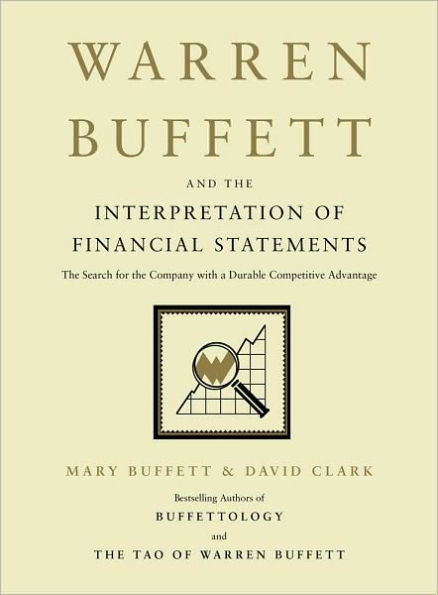Table of Contents
Introduction
Chapter 1: Two Great Revelations That Made Warren the Richest Person in the World
Chapter 2: The Kind of Business That Will Make Warren Superrich
Chapter 3: Where Warren Starts His Search for the Exceptional Company
Chapter 4: Durability Is Warren's Ticket to Riches
Chapter 5: Financial Statement Overview: Where the Gold Is Hidden
Chapter 6: Where Warren Goes to Find Financial Information
THE INCOME STATEMENT
Chapter 7: Where Warren Starts: The Income Statement
Chapter 8: Revenue: Where the Money Comes In
Chapter 9: Cost of Goods Sold: For Warren the Lower the Better
Chapter 10: Gross Profit/Gross Profit Margin: Key Numbers for Warren in His Search for Long-Term Gold
Chapter 11: Operating Expenses: Where Warren Keeps a Careful Eye
Chapter 12: Selling, General, and Administrative Expenses
Chapter 13: Research and Development: Why Warren Stays Away from It
Chapter 14: Depreciation: A Cost Warren Can't Ignore
Chapter 15: Interest Expense: What Warren Doesn't Want
Chapter 16: Gain (or Loss) on Sale of Assets and Other
Chapter 17: Income Before Tax: The Number That Warren Uses
Chapter 18: Income Taxes Paid: How Warren Knows Who Is Telling the Truth
Chapter 19: Net Earnings: What Warren Is Looking For
Chapter 20: Per-Share Earnings: How Warren Tells the Winners from the Losers
BALANCE SHEET
Chapter 21: Balance Sheet in General
Chapter 22: Assets
Chapter 23: Current Asset Cycle: How the Money Is Made
Chapter 24: Cash and Cash Equivalents: Warren's Pile of Loot
Chapter 25: Inventory: What the Company Needs to Buy and What the Company Needs to Sell
Chapter 26: Net Receivables: Money Owed to the Company
Chapter 27: Prepaid Expenses/Other Current Assets
Chapter 28: Total Current Assets and the Current Ratio
Chapter 29: Property, Plant, and Equipment: For Warren Not Having Them Can Be a Good Thing
Chapter 30: Goodwill
Chapter 31: Intangible Assets: Measuring the Unmeasurable
Chapter 32: Long-Term Investments: One of the Secrets to Warren's Success
Chapter 33: Other Long-Term Assets
Chapter 34: Total Assets and the Return on Total Assets
Chapter 35: Current Liabilities
Chapter 36: Accounts Payable, Accrued Expenses, and Other Current Liabilities
Chapter 37: Short-Term Debt: How It Can Kill a Financial Institution
Chapter 38: Long-Term Debt Coming Due and the Troubles It Can Cause
Chapter 39: Total Current Liabilities and the Current Ratio
Chapter 40: Long-Term Debt: Something That Great Companies Don't Have a Lot Of
Chapter 41: Deferred Income Tax, Minority Interest, and Other Liabilities
Chapter 42: Total Liabilities and the Debt to Shareholders' Equity Ratio
Chapter 43: Shareholders' Equity/Book Value
Chapter 44: Preferred and Common Stock: Additional Paid in Capital
Chapter 45: Retained Earnings: Warren's Secret for Getting Superrich
Chapter 46: Treasury Stock: Warren Likes to See This on the Balance Sheet
Chapter 47: Return on Shareholders' Equity: Part One
Chapter 48: Return on Shareholders' Equity: Part Two
Chapter 49: The Problem with Leverage and the Tricks It Can Play on You
THE CASH FLOW STATEMENT
Chapter 50: The Cash Flow Statement: Where Warren Goes to Find the Cash
Chapter 51: Capital Expenditures: Not Having Them Is One of the Secrets to Getting Rich
Chapter 52: Stock Buybacks: Warren's Tax-Free Way to Increase Shareholder Wealth
VALUING THE COMPANY WITH A DURABLE COMPETITIVE ADVANTAGE
Chapter 53: Warren's Revolutionary Idea of the Equity Bond and How It Has Made Him Superrich
Chapter 54: The Ever-Increasing Yield Created by the Durable Competitive Advantage
Chapter 55: More Ways to Value a Company with a Durable Competitive Advantage
Chapter 56: How Warren Determines the Right Time to Buy a Fantastic Business
Chapter 57: How Warren Determines It Is Time to Sell
Appendix
Select Glossary of Terms
Acknowledgments
Index






